Reinforcement of Frictional Vibration Noise Reduction Properties of a Polymer Material by PTFE Particles
Abstract
:1. Introduction
2. Methods and Experiments
2.1. Experimental Materials
2.2. Experimental Apparatus and Wear Tests
2.3. Measurement Techniques and Procedures
3. Results
3.1. Analysis of Coefficients of Friction
3.2. Analysis of Wear Mass Loss
3.3. Analysis of Frictional Vibration and Noise Behaviors
3.4. Analysis of Wear Surfaces
4. Discussion
5. Conclusions
- (a)
- PTFE particles reduced the COFs and wear mass losses of the TPU composites, with 9% PTFE reducing the COF and wear mass losses by more than 50% and 40%, respectively.
- (b)
- A suitable mass content of PTFE obviously weakened the amplitudes of the main vibration frequencies of the TPU materials, as well as eliminated vibration waveforms at higher frequencies.
- (c)
- The lower COFs of TPU modified with PTFE resulted in a small fluctuation amplitude, which improved the stability of the tribological system, resulting in an ideal reduction in frictional vibration and noise.
Author Contributions
Funding
Institutional Review Board Statement
Informed Consent Statement
Data Availability Statement
Conflicts of Interest
References
- Dong, C.L.; Yang, Y.Y.; Yuan, C.Q.; Bai, X.Q.; Guo, Z.W. Effects of anisotropy of lignum vitae wood on its tribological performances. Compos. Part B Eng. 2022, 228, 109426. [Google Scholar] [CrossRef]
- Wiese, F.K.; Ryan, P.C. The extent of chronic marine oil pollution in southeastern Newfoundland waters assessed through beached bird surveys 1984–1999. Mar. Pollut. Bull. 2003, 46, 1090–1101. [Google Scholar] [CrossRef]
- Han, H.S.; Lee, K.H. Experimental verification of the mechanism on stick-slip nonlinear friction induced vibration and its evaluation method in water-lubricated stern tube bearing. Ocean. Eng. 2019, 182, 147–161. [Google Scholar] [CrossRef]
- Dong, C.L.; Yuan, C.Q.; Bai, X.Q.; Yang, Y.; Yan, X.P. Study on wear behaviours for NBR/stainless steel under sand water-lubricated conditions. Wear 2015, 332–333, 1012–1020. [Google Scholar] [CrossRef]
- Chaudhuri, H.; Karak, N. Water dispersed bio-derived transparent polyurethane: Synthesis, properties including chemical resistance, UV-aging, and biodegradability. Prog. Org. Coat. 2020, 146, 105730. [Google Scholar] [CrossRef]
- Naureen, B.; Haseeb, A.S.M.A.; Basirun, W.J.; Muhamad, F. Recent advances in tissue engineering scaffolds based on polyurethane and modified polyurethane. Mater. Sci. Eng. C 2021, 118, 111228. [Google Scholar] [CrossRef] [PubMed]
- Jiang, S.L.; Yuan, C.Q.; Guo, Z.W.; Bai, X.Q. Effect of crosslink on tribological performance of polyurethane bearing material. Tribol. Int. 2019, 136, 276–284. [Google Scholar] [CrossRef]
- Meicke, S.; Paasch, R. Seawater lubricated polymer journal bearings for use in wave energy converters. Renew. Energ. 2012, 39, 463–470. [Google Scholar] [CrossRef]
- Litwin, W.; Dymarski, C. Experimental research on water-lubricated marine stern tube bearings in conditions of improper lubrication and cooling causing rapid bush wear. Tribol. Int. 2016, 95, 449–455. [Google Scholar] [CrossRef]
- Dong, C.L.; Yuan, C.Q.; Bai, X.Q.; Qin, H.L.; Yan, X.P. Investigating relationship between deformation behaviours and stick-slip phenomena of polymer material. Wear 2017, 376–377, 1333–1338. [Google Scholar] [CrossRef]
- Sanchez, C.; Chen, Y.; Parkinson, D.Y.; Liang, H. In situ probing of stress-induced nanoparticle dispersion and friction reduction in lubricating grease. Tribol. Int. 2017, 111, 66–72. [Google Scholar] [CrossRef] [Green Version]
- Hirani, H.; Verma, M. Tribological study of elastomeric bearings for marine propeller shaft system. Tribol. Int. 2009, 42, 378–390. [Google Scholar] [CrossRef]
- Bouyer, J.; Alexandre, Y.; Fillon, M. Experimental investigation on the influence of a multi-scratched shaft on hydrodynamic journal bearing performance. Tribol. Int. 2021, 153, 106543. [Google Scholar] [CrossRef]
- Mahdi, D.; Riches, A.; Gester, M.; Yeomans, J.; Smith, P. Rolling and sliding: Separation of adhesion and deformation friction and their relative contribution to total friction. Tribol. Int. 2015, 89, 128–134. [Google Scholar] [CrossRef]
- Dong, C.L.; Yuan, C.Q.; Bai, X.Q.; Tian, Y. A novel approach to reduce deformation behaviours of HDPE polymer during friction. Appl. Surf. Sci. 2020, 503, 144311. [Google Scholar] [CrossRef]
- Dong, C.L.; Shi, L.C.; Li, L.Z.; Bai, X.Q.; Yuan, C.Q.; Tian, Y. Stick-slip behaviours of water lubrication polymer materials under low speed conditions. Tribol. Int. 2017, 106, 55–61. [Google Scholar] [CrossRef]
- Chan, N.; Balakrishna, S.G.; Klemenz, A.; Moseler, M.; Egberts, P.; Bennewitz, R. Contrast in nanoscale friction between rotational domains of graphene on Pt(111). Carbon 2017, 113, 132–138. [Google Scholar] [CrossRef]
- Chen, Y.; Simon, B.T.; Opperman, L.A.; Renner, P.; Parkinson, D.; Sinyukov, A.; Liang, H. Using nanoparticles to prevent enamel wear. Biotribology 2021, 26, 100168. [Google Scholar] [CrossRef]
- Yang, M.M.; Zhang, Z.Z.; Yuan, J.; Wu, L.; Zhao, X.; Guo, F.; Men, X.; Liu, W.M. Fabrication of PTFE/Nomex fabric/phenolic composites using a layer-by-layer self-assembly method for tribology field application. Friction 2020, 8, 335–342. [Google Scholar] [CrossRef] [Green Version]
- Cui, Y.X.; Ding, M.; Sui, T.Y.; Zheng, W.; Qiao, G.C.; Yan, S.; Liu, X.B. Role of nanoparticle materials as water-based lubricant additives for ceramics. Tribol. Int. 2020, 142, 105978. [Google Scholar] [CrossRef]
- Lin, W.; Kluzek, M.; Iuster, N.; Shimoni, E.; Kampf, N.; Goldberg, R.; Klein, J. Cartilage-inspired, lipid-based boundary-lubricated hydrogels. Science 2020, 370, 335–338. [Google Scholar] [CrossRef]
- Chen, L.; Hu, W.X.; Du, M.; Song, Y.; Wu, Z.; Zheng, Q. Bioinspired, recyclable, stretchable hydrogel with boundary ultralubrication. ACS Appl. Mater. Inter. 2021, 13, 42240–42249. [Google Scholar] [CrossRef]
- Wani, T.P.; Raja, R.; Sampathkumaran, P.; Seetharamu, S. Investigation on wear and friction characteristics of bi-directional silk fiber reinforced nanoclay added HDPE composites. Mater. Today Proc. 2018, 5, 25713–25719. [Google Scholar] [CrossRef]
- Song, J.F.; Zhao, G. A molecular dynamics study on water lubrication of PTFE sliding against copper. Tribol. Int. 2019, 136, 234–239. [Google Scholar] [CrossRef]
- Liu, S.T.; Dong, C.L.; Yuan, C.Q.; Bai, X.Q.; Tian, Y.; Zhang, G.L. A new polyimide matrix composite to improve friction-induced chatter performance through reducing fluctuation in friction force. Compos. Part B Eng. 2021, 217, 108887. [Google Scholar] [CrossRef]
- Ding, L.; Axinte, D.; Smith, P.B.; Hassan, A.A. Study on the characterisation of the PTFE transfer film and the dimensional designing of surface texturing in a dry-lubricated bearing system. Wear 2020, 448–449, 203238. [Google Scholar] [CrossRef]
- Bombard, A.J.F.; Vicente, J.D. Boundary lubrication of magnetorheological fluids in PTFE/steel point contacts. Wear 2012, 296, 484–490. [Google Scholar] [CrossRef]
- Sangeetha, S.; Kalaignan, G.P.; Anthuvan, J.T. Pulse electrodeposition of self-lubricating Ni–W/PTFE nanocomposite coatings on mild steel surface. Appl. Surf. Sci. 2015, 359, 412–419. [Google Scholar] [CrossRef]
- Puts, G.J.; Crouse, P.; Ameduri, B.M. Polytetrafluoroethylene: Synthesis and characterization of the original extreme polymer. Chem. Rev. 2019, 119, 1763–1805. [Google Scholar] [CrossRef]
- Dhanumalayan, E.; Joshi, G.M. Performance properties and applications of polytetrafluoroethylene (PTFE)—A review. Adv. Compos. Hybrid. Mater. 2018, 1, 247–268. [Google Scholar] [CrossRef]
- Atiqah, A.; Jawaid, M.; Sapuan, S.M.; Ishak, M.R.; Ansari, M.N.M.; Ilyas, R.A. Physical and thermal properties of treated sugar palm/glass fibre reinforced thermoplastic polyurethane hybrid composites. J. Mater. Res. Technol. 2019, 8, 3726–3732. [Google Scholar] [CrossRef]
- Sharma, V.; Timmons, R.; Erdemir, A.; Pranesh, B.; Aswath, O. Plasma-functionalized polytetrafluoroethylene nanoparticles for improved wear in lubricated contact. ACS Appl. Mater. Inter. 2017, 9, 25631–25641. [Google Scholar] [CrossRef]
- Xie, C.J.; Wang, K.J. Synergistic modification of the tribological properties of polytetrafluoroethylene with polyimide and boron nitride. Friction 2021, 9, 1474–1491. [Google Scholar] [CrossRef]
- Vishal, K.; Rajkumar, K.; Sabarinathan, P. Effect of recovered silicon filler inclusion on mechanical and tribological properties of polytetrafluoroethylene (PTFE) composite. Silicon 2021, 63, 1–10. [Google Scholar] [CrossRef]
- Blanchet, T.A.; Kennedy, F.E. Sliding wear mechanism of polytetrafluoroethylene (PTFE) and PTFE composites. Wear 1992, 153, 229–243. [Google Scholar] [CrossRef]
- Bahadur, S.; Tabor, D. The wear of filled polytetrafluoroethylene. Wear 1984, 98, 1–13. [Google Scholar] [CrossRef]
- Golchin, A.; Simmons, G.F.; Glavatskih, S.B. Break-away friction of PTFE materials in lubricated conditions. Tribol. Int. 2012, 48, 54–62. [Google Scholar] [CrossRef]
- Toumi, S.; Fouvry, S.; Salvia, M. Prediction of sliding speed and normal force effects on friction and wear rate evolution in a dry oscillating-fretting PTFE/Ti-6A1-4V contact. Wear 2017, 376–377, 1365–1378. [Google Scholar] [CrossRef]

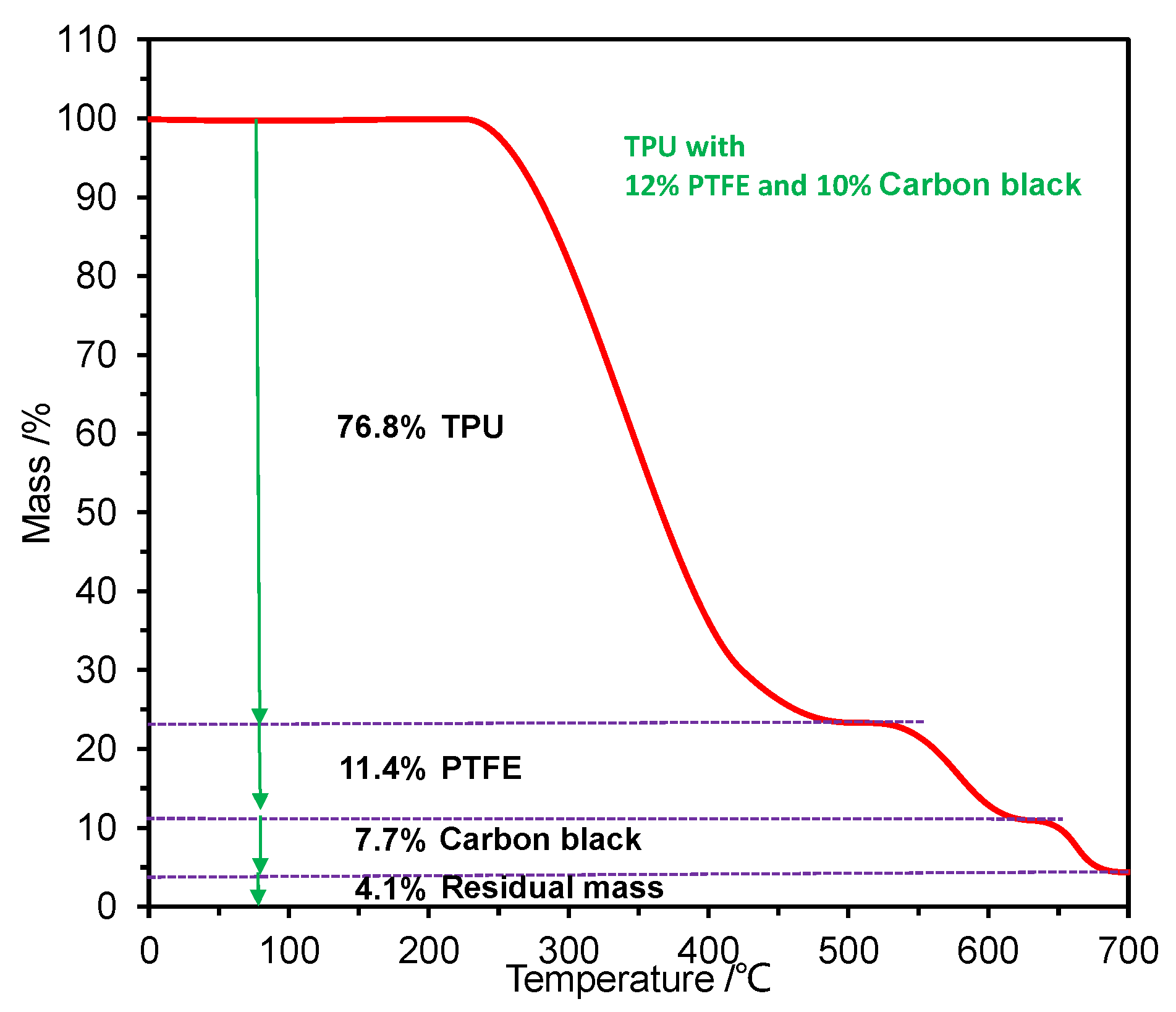
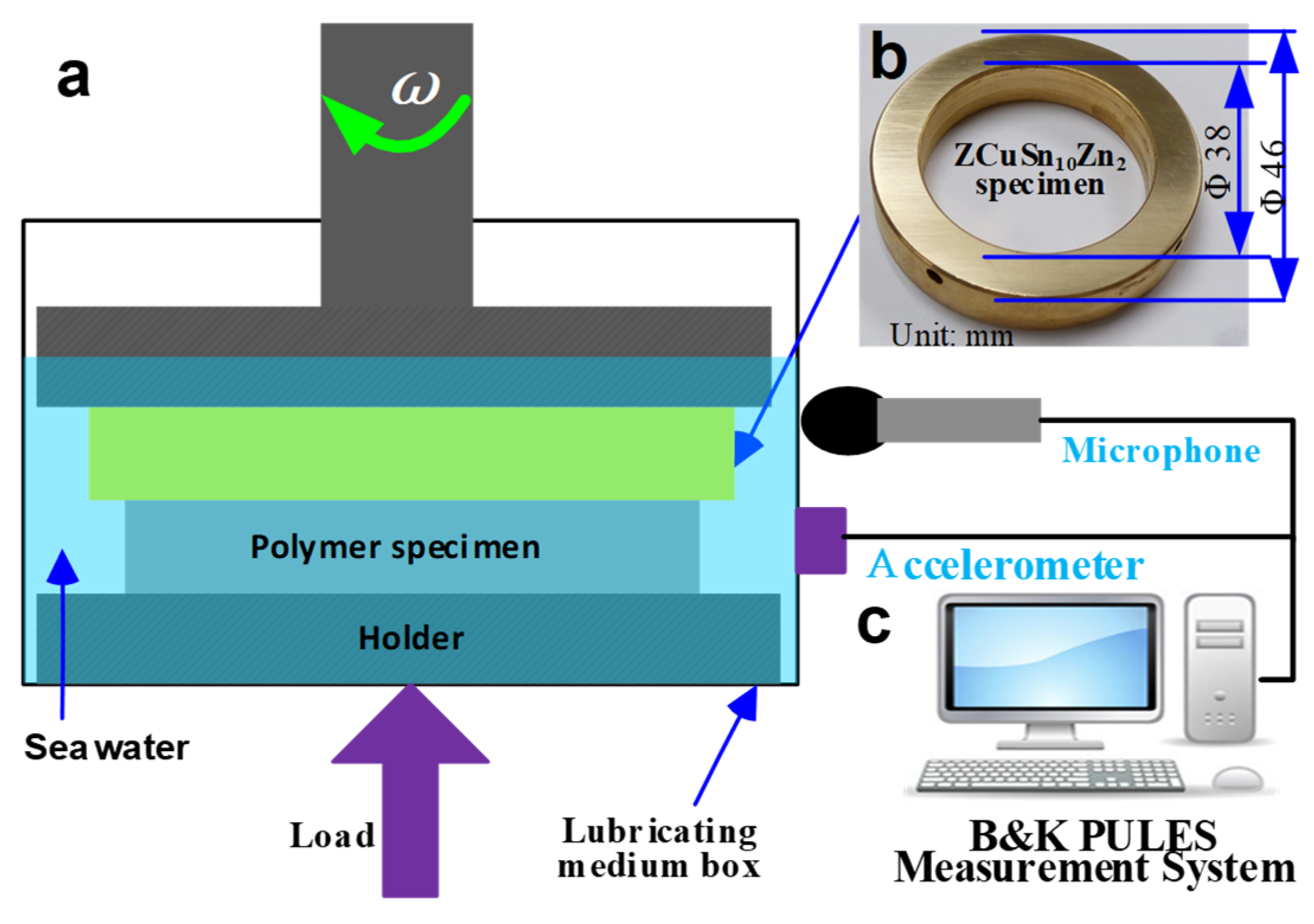

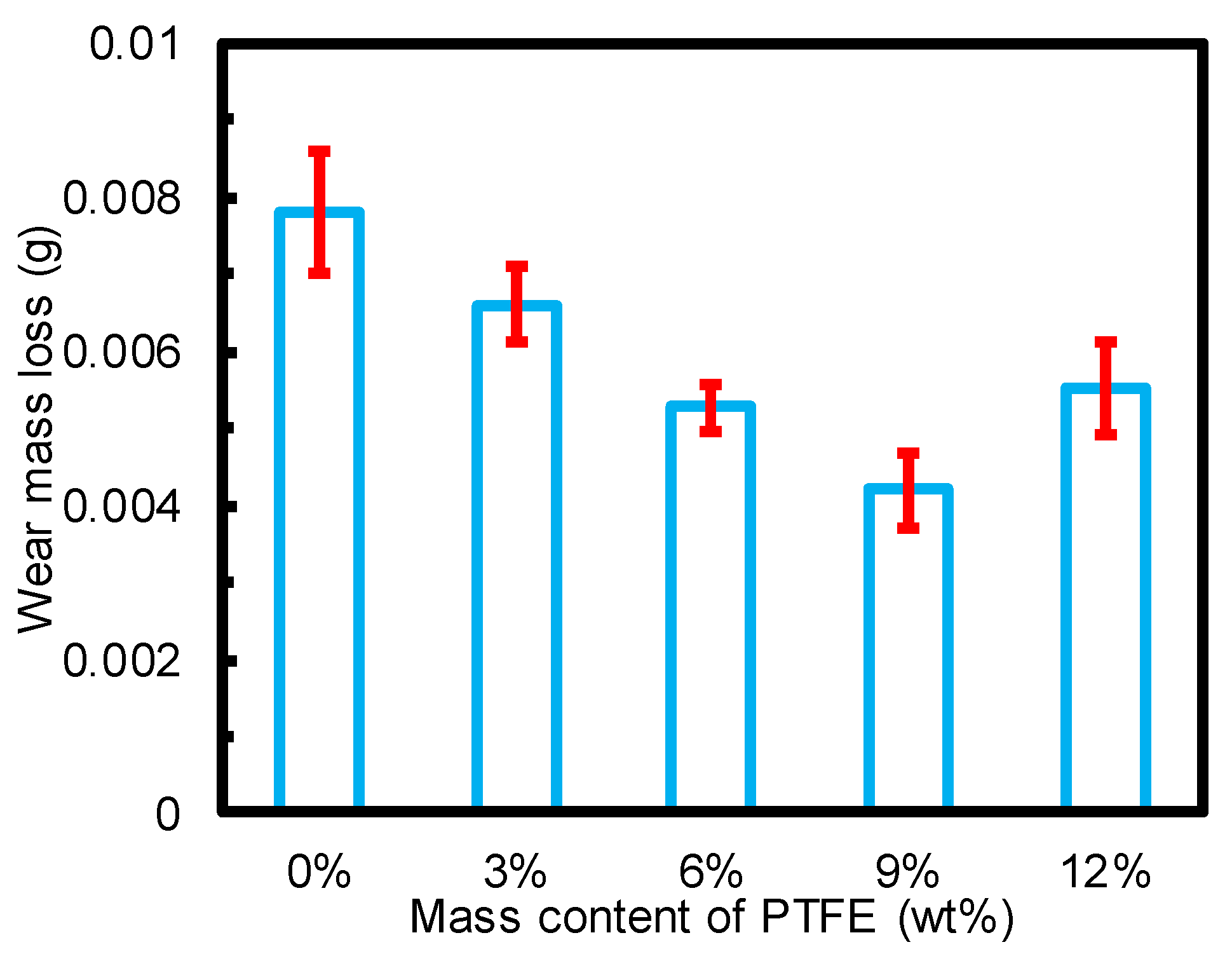
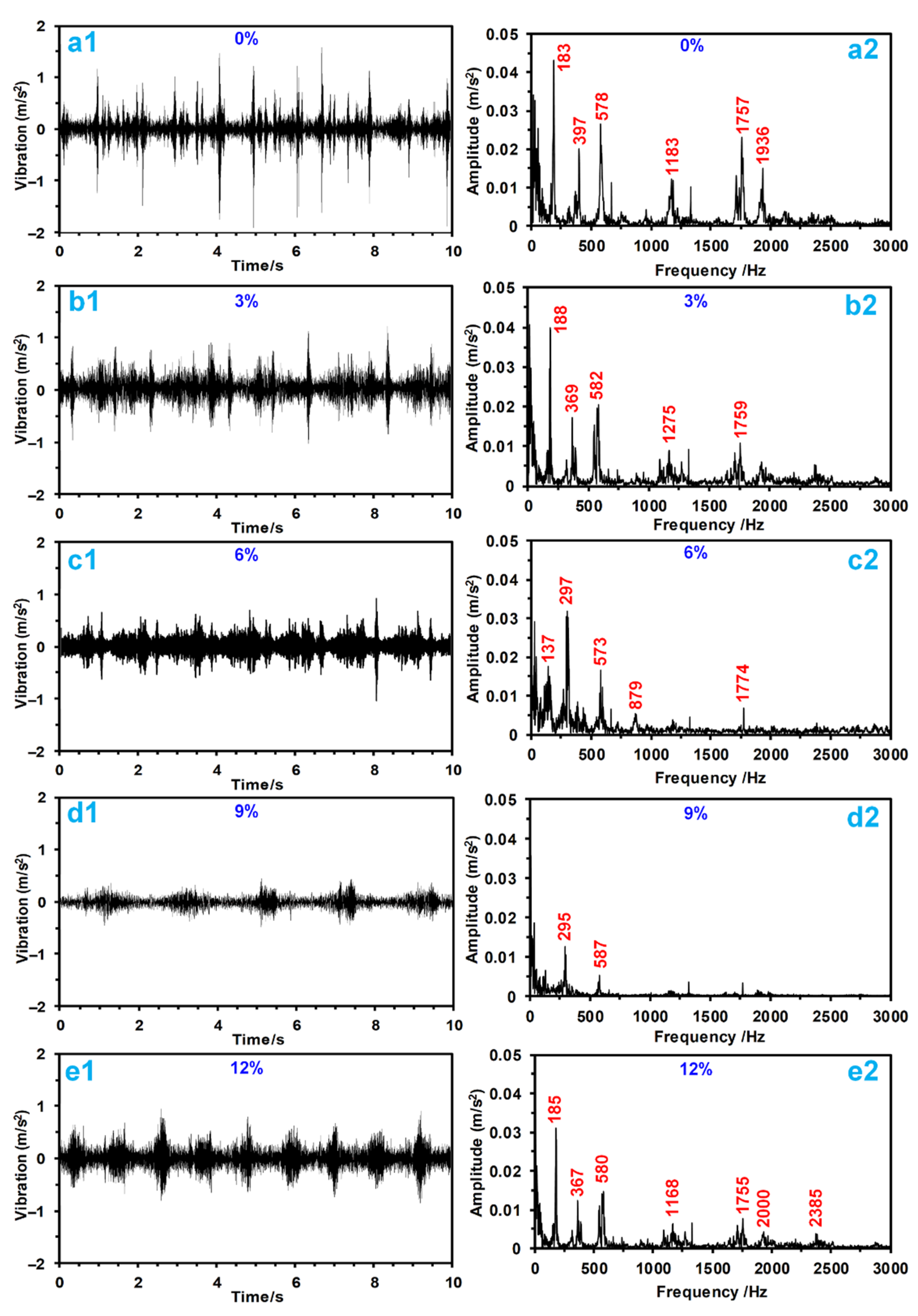
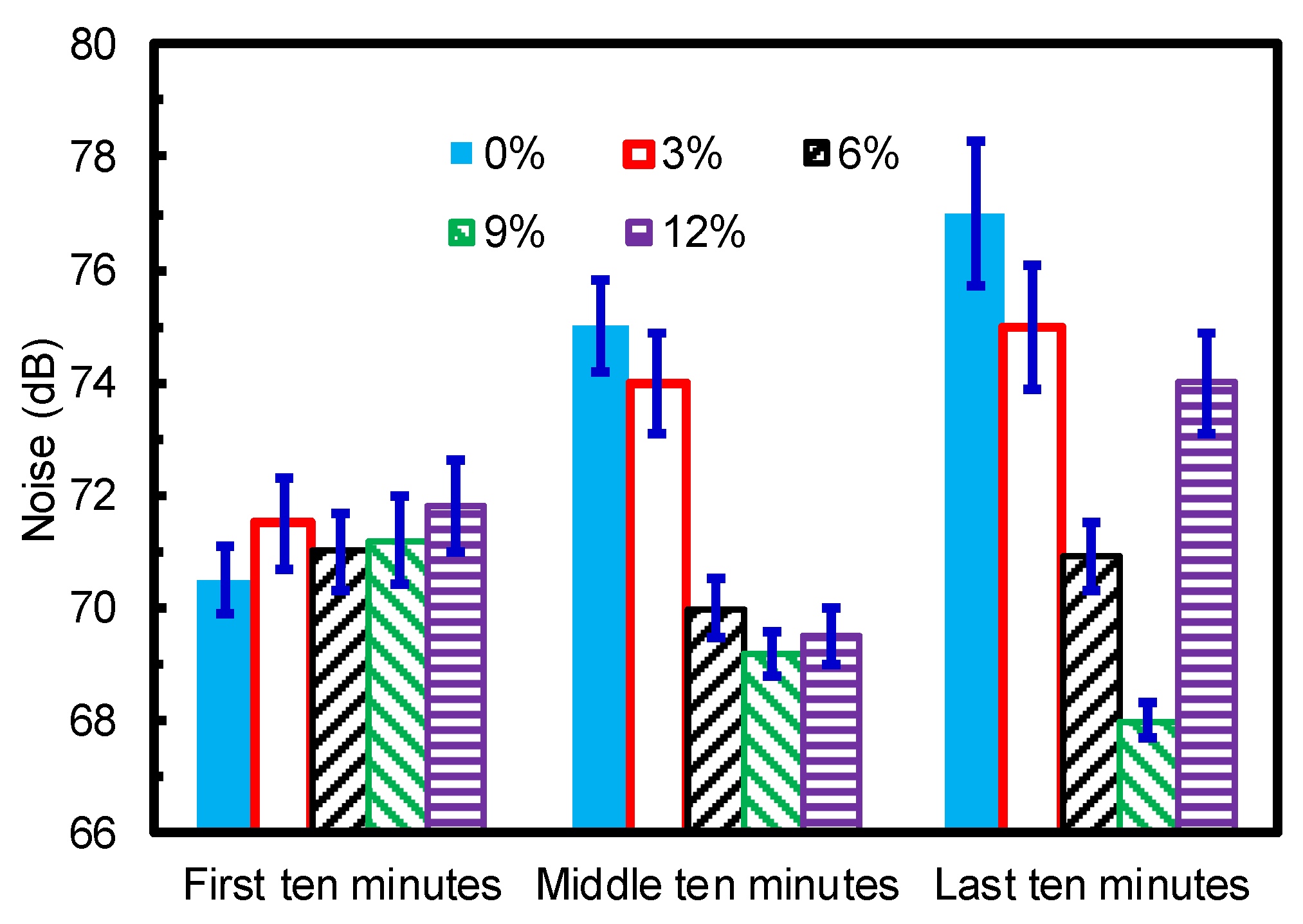
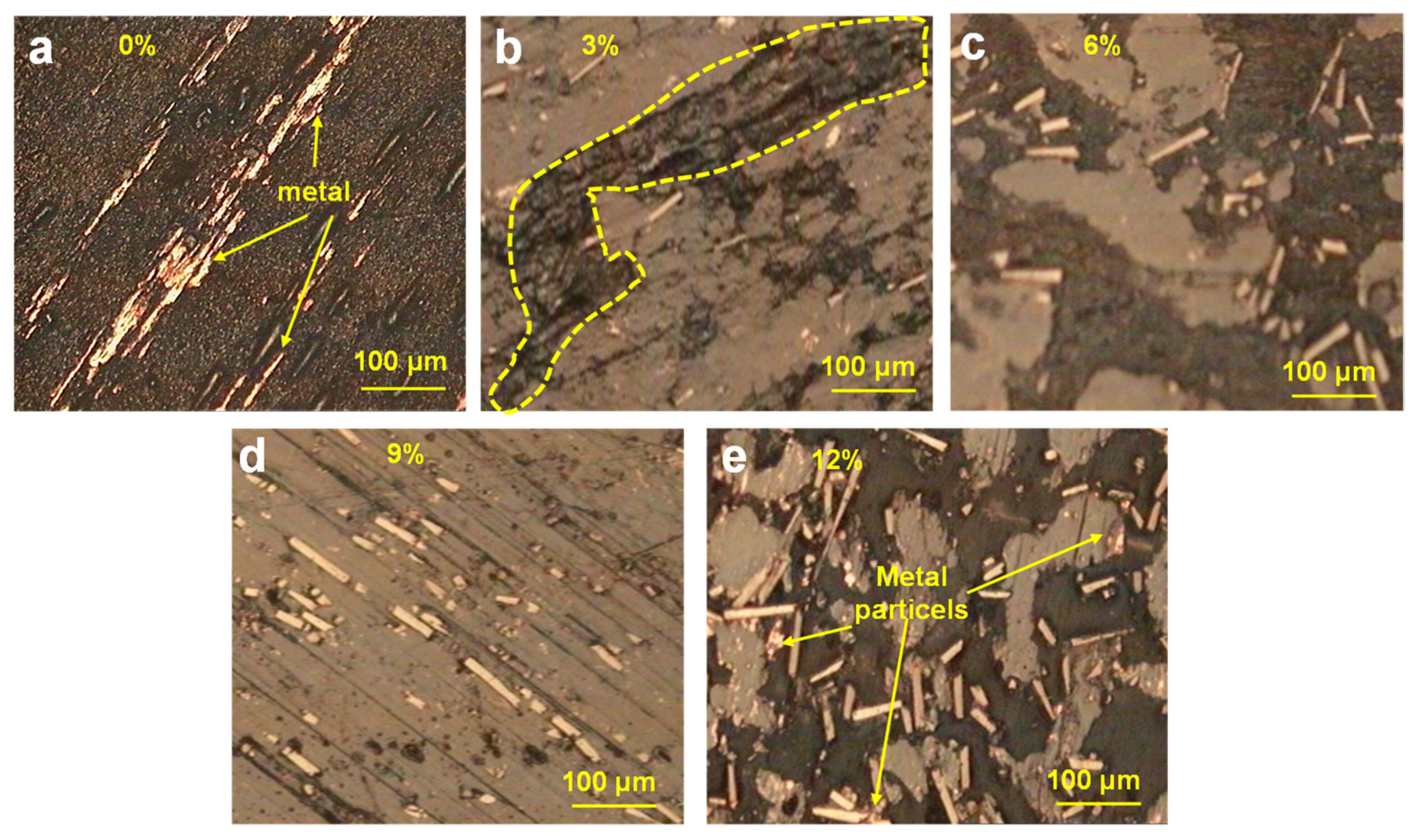
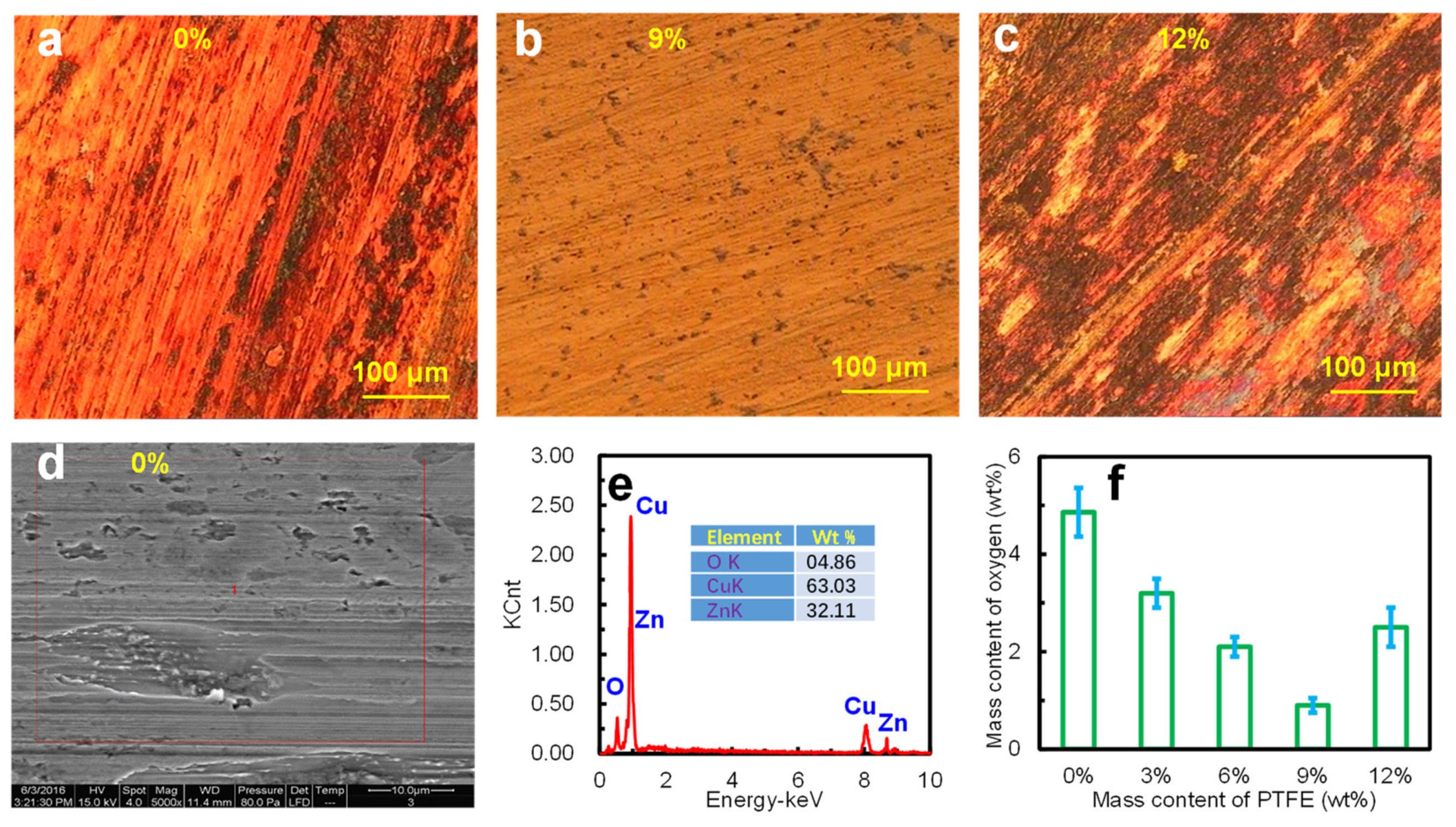
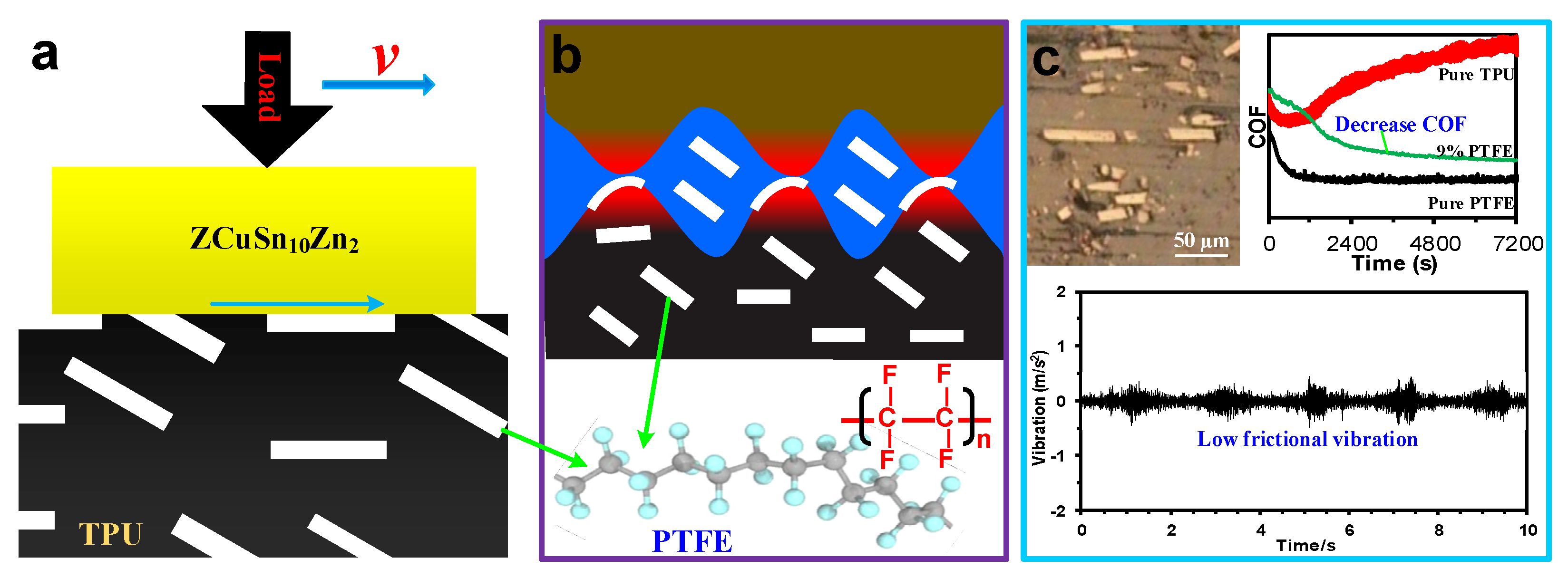
| Shore Hardness (A) | Tensile Strength (MPa) | Elastic Model (MPa) | Elongation at Break (%) | Melting Point (°C) | Density (kg/m3) | Maximum Operating Temperature without Load (°C) | |
|---|---|---|---|---|---|---|---|
| PTFE | 65 | 27.6 | 280 | 238 | 327 | 2.19×103 | 260 |
| TPU | 85 | 35 | 400 | 350 | 190 | 1.18×103 | 140 |
| Modified TPU Composites | TPU with No PTFE | TPU with 3% PTFE | TPU with 6% PTFE | TPU with 9% PTFE | TPU with 12% PTFE |
|---|---|---|---|---|---|
| TPU | 180 g | 174 g | 168 g | 162 g | 146 g |
| PTFE particle | 0 g | 6 g | 12 g | 18 g | 24 g |
| Carbon black (N772) | 20 g | 20 g | 20 g | 20 g | 20 g |
Publisher’s Note: MDPI stays neutral with regard to jurisdictional claims in published maps and institutional affiliations. |
© 2022 by the authors. Licensee MDPI, Basel, Switzerland. This article is an open access article distributed under the terms and conditions of the Creative Commons Attribution (CC BY) license (https://creativecommons.org/licenses/by/4.0/).
Share and Cite
Li, N.; Dong, C.; Wu, Y. Reinforcement of Frictional Vibration Noise Reduction Properties of a Polymer Material by PTFE Particles. Materials 2022, 15, 1365. https://doi.org/10.3390/ma15041365
Li N, Dong C, Wu Y. Reinforcement of Frictional Vibration Noise Reduction Properties of a Polymer Material by PTFE Particles. Materials. 2022; 15(4):1365. https://doi.org/10.3390/ma15041365
Chicago/Turabian StyleLi, Naner, Conglin Dong, and Yuhang Wu. 2022. "Reinforcement of Frictional Vibration Noise Reduction Properties of a Polymer Material by PTFE Particles" Materials 15, no. 4: 1365. https://doi.org/10.3390/ma15041365






